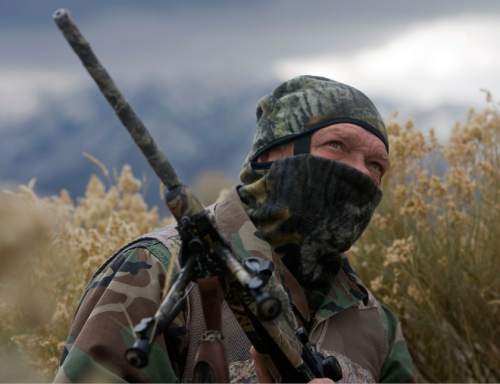This is an archived article that was published on sltrib.com in 2014, and information in the article may be outdated. It is provided only for personal research purposes and may not be reprinted.
Utahns killed slightly fewer coyotes in the second year of the Mule Deer Preservation Act, but the $50 bounty paid for each animal is only one piece of the state's effort to remove the predator.
The program's second year, which concluded June 30, ended with 7,041 coyotes turned in, down from 7,160 animals the previous year. The number of people collecting bounties rose by 4 percent to 1,055, according to a Division of Wildlife Resources (DWR) report issued last week.
Sen. Ralph Okerlund, R-Monroe, sponsored the Mule Deer Preservation Act during the 2012 Legislature. He and other hunters figured the bounty would result in 20,000 coyotes being turned in each year.
The bill set aside $500,000 for the program.
Those numbers have not been reached, but DWR biologists say the number of coyotes being killed through various programs — including contracted hunters — has increased since the act took effect and that likely is helping deer herds increase.
"When you are dealing with coyotes, it is hard to tell exactly what impact is happening because we do not know their population," said Leslie McFarlane, mammals program coordinator for DWR. "Sustained harvest over multiple years has to have some effect [on mule deer populations]."
The Targeted Predator Control Program was created as part of the act and allows the DWR to contract individuals to eliminate coyotes from specific areas. Biologists sent those contracted coyote hunters to areas where the deer population is less than 90 percent of the agency's objective and fawn-to-doe ratios are lower than expected.
The state spent $140,000 to fund 14 coyote-removal contracts in the recent budget year, resulting in a net cost of $593 per animal. The year before, three hired guns were paid $45,000.
"It may take several years of implementation of this program before improvements in fawn/doe ratios statewide may be observed and this effect may be more visible on a unit by unit basis," reads the report, titled "Utah's Predator Control Program Summary."
Utah, unlike other Western states, is reporting an increase in mule deer numbers in recent years, although most of the credit is being given to expansive habitat-restoration efforts.
DWR reports an estimated 12,564 coyotes were killed during the second year of the act through public rewards (7,041), the contractors (236), general fur harvest/trapping (2,682) and the federal Wildlife Services program (2,605).
The average number of coyotes reported killed before the act was 7,397, according to the report.
People collecting the bounty are required to submit a data form with the GPS coordinates of the kill and the scalp of the coyote with both ears attached and the lower jaw. The report shows that 67 percent of coyotes turned in were shot, 23 percent were trapped, and 5 percent were harvested by other means, such as dogs or as road kill.
Six wildlife management units (Box Elder, West Desert, Southwest Desert, Fillmore, Beaver and Pine Valley) accounted for about half the statewide totals. Two-thirds of participants submitted five or fewer coyotes.
"The program likely increased the numbers of coyotes killed in Utah and provided government-supplied economic rewards to individuals and businesses throughout the state," reads the report. "Based on two years of data collected we estimate that 25,054 coyotes were killed. This is a 59 percent increase in the previous estimated annual harvest of 7,397 coyotes per year."



